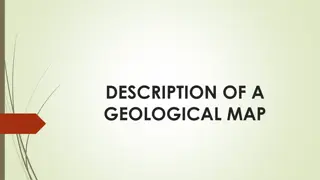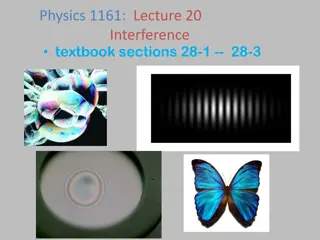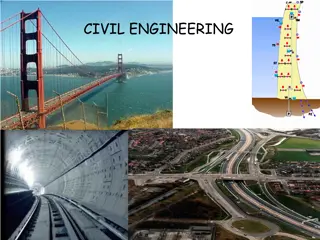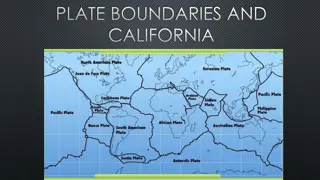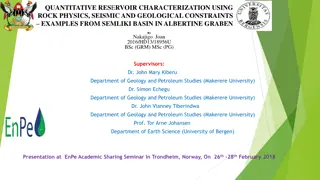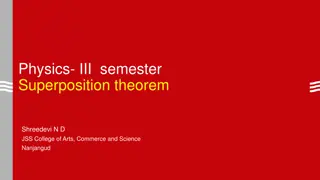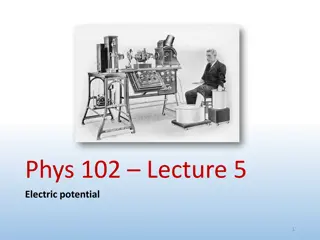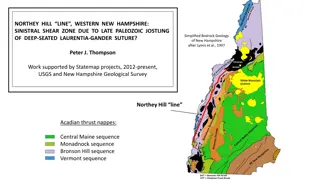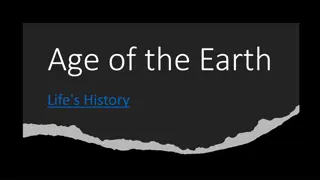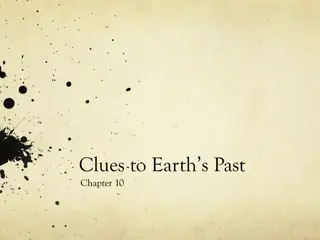Unraveling Geological Mysteries with the Law of Superposition
In the world of geology, the Law of Superposition plays a crucial role in deciphering the Earth's history. This law helps determine the relative ages of different geological layers by examining their sequence of formation. By understanding how sedimentary rocks are deposited over time, we gain insights into past environments and the processes that shaped our planet. Through the exploration of geological strata, we can piece together a timeline of Earth's evolution and uncover hidden clues to our planet's past.
Uploaded on Feb 24, 2025 | 14 Views
Download Presentation

Please find below an Image/Link to download the presentation.
The content on the website is provided AS IS for your information and personal use only. It may not be sold, licensed, or shared on other websites without obtaining consent from the author.If you encounter any issues during the download, it is possible that the publisher has removed the file from their server.
You are allowed to download the files provided on this website for personal or commercial use, subject to the condition that they are used lawfully. All files are the property of their respective owners.
The content on the website is provided AS IS for your information and personal use only. It may not be sold, licensed, or shared on other websites without obtaining consent from the author.
E N D
Presentation Transcript
These stations compliment the TIES PowerPoint. Each station takes about 15 minutes. Slides 2-8 should be laminated and place at stations throughout the classroom. Each student should receive slides 9-16 to serve as their worksheets. Answers and instructions are written in the comment section below each slide. Evidence for Evolution Stations
Believe it or not, you have a time portal right there in your very own backyard, which can take you way back through the ages, even all the way back to the Jurassic Era! Can you see it? No? Now, don't go blaming your eyes if you don't see it. Trust me, your eyesight is just fine. The real reason why you aren't seeing it is because you are looking in the wrong direction. The time portal is located right there under your own two feet. The very ground that you tread upon each day is a time portal. Hidden beneath it are the mysteries of several past centuries, which can only be unraveled by the true explorers - the geologists. They are the present-day time travelers, who are able to peer through the veil of time back into the past. Today we shall learn about one of the most important geological tools around - the 'Law of Superposition'. In an undisturbed collection of sediment or rock; the layer on the top is the youngest layer, while that at the bottom is the oldest. For instance, if in a given sample, a layer of limestone is present on top of a layer of shale stone, then the limestone layer is the younger of the two. Definition of the Law of Superposition From this definition, it is clear that the law of superposition is concerned with the different layers of the Earth, and their respective ages. It helps in the determination of the age of a particular layer of earth, relative to the ages of the layers that are above and below it. The law of superposition is one of the most fundamental principles of stratigraphy - the branch of archeology which studies the geological layers of the Earth and soil. This law has a proven record of being able to accurately determine the relative ages of the different layers of soil.
Law of Superposition: Meaning The formation of the different layers of soil is a result of the erosion of rocks over millions of years. Natural erosive agents such as wind, flowing water, etc., erode rocks, breaking off small particles from their surfaces. These particles, along with the minerals in them, get broken down into fine soil, which is then deposited on distant plains and other large land masses. As this process continues, many years later, several layers of soil are formed one over the other on the site of deposition, just like the cards in a deck. The card at the bottom of the deck is always placed first while, and as the stack gets built, the one on the top is placed last. Similarly, the topmost layer of soil is the most recent one, while the bottommost is the oldest among the different layers of soil. This forms the basis of the working on the law of superposition. The law implies that each layer of soil is younger than the one below it, and conversely, each layer of soil is older than the one that is above it. The law is also applicable to volcanic formations, wherein, molten magma erupts and spreads over older flows, solidifying into a new layer. In such formations too, each new layer formed is younger than the one below it. Catch the Culprit Sherlock Holmes was called to a scene of crime, where the wife of the owner of the house was murdered. It had rained during the night, so the ground was full of footprints and tire tracks. By observing these, and by interrogating the tenants of the house, Sherlock Homes was able to catch the culprit. Look at the illustration of the prints on the ground at the crime scene, followed by the result of the interrogation. 1) The owner of the house drives a car. 2) The maid rides a bicycle to work. 3) The cook rides a motorcycle. 4) The butler walks to work. 5) The neighbor has a dog, and visits often. From this information, can you determine who the culprit was?
2) Arrange the events 2) Arrange the events chronologically chronologically Number the events shown in the illustration below, in the order of their occurrence 1 - 7.
Name: ________________________________________ VESTIGIAL STRUCTURES An organ or part of an organ which is greatly reduced from the original form and is no longer functional or has a reduced or altered function is a vestigial structure. Vestigial structures provide a clue to the evolutional history of a species because they are leftovers of structures found in the ancestral species. Snakes evolved from four legged animals similar to lizards. Most species of snakes have lost all traces of limbs but snakes in the boa and python family have a tiny pair of hind legs. Unlike whales, the python's vestigial legs can actually be seen as a pair of "spurs" that stick out where the body ends and the tail begins. 1. Snakes have legs. Do they use them? Do they walk? 2. Explain why snake legs are vestigial. 3. Explain how a vestigial organ is evidence of evolution.
Name: ________________________________________ HOMOLOGOUS STRUCTURES Structures derived from a common ancestor or same evolutionary or developmental origin . Homologous structures may not necessarily perform the same function but they share a common ancestral origin. For instance, the forelimbs of humans and bats are homologous structures. Although they are used differently, the basic skeletal structure is the same and they are derived from the same embryonic origin. Their similarity in this regard could indicate a likely evolution from a common ancestor. 1. How are the limbs similar? 2. How are the limbs different? 3. How are they evidence of evolution?
Name: ________________________________________ DNA Remove 2 strips from the envelope. Count the number of nucleotides (letters) that differ between the two strips and record on the grid. Continue until you have recorded all strips. After you have recorded your data, answer the following questions. Review your data table, you will find that the numbers sort into two groups. Pairs with 2-4 differences, then pairs with 7-18 differences. 1. List the pairs of species with only 2-4 differences in their DNA. 2. Notice in the set of 9 pairings that there are 4 species that are found in all possible combinations with each other. What those species? 3. What does this suggest about how close these 4 species are related? 2 Porpoise S. Whale 3 3 3 3 4 3 3 4
The law of superposition law of superposition proves to be a useful tool for establishing the interrelation between different layers of soil in terms of their respective ages. It forms an integral part of modern-day geology and other natural sciences. 1) Catch the Culprit Using the illustration, can you determine who the culprit was? 2) Arrange the events chronologically Number the events shown in the illustration below, in the order of their occurrence 1 - 7. _________ earthquake _________ deposit A _________ deposit P _________ deposit G _________ deposit D _________ river cuts through (C) _________ deposit M Answer: ___________
2. How did scientists know where to look for Tiktaalik? ? 2. How did scientists know where to look for Tiktaalik be discovered? be discovered? 1. After fossils are buried, how do they get to the surface to Using the text answer these questions: Visit https://tiktaalik.uchicago.edu/fossils101.html Create a fossil rub with your favorite plate. After fossils are buried, how do they get to the surface to
for more on biogeography. https://evolution.berkeley.edu/evolibrary/article/history_16 Visit idea of biogeography. Take 7 notes, paying attention to sloth adaptations and the energy? week, for a bathroom break. How are these creatures so low fact, they descend from their treetops canopies just once a Sloths spend most of their time eating, resting, or sleeping; in Watch TED ED Why are Sloths So Slow
Bladderworts Venus Fly Traps Pitcher Plants excellent example. convergent evolution convergent evolution and why carnivorous plants are an related. Using your textbook/online resources, explain what is Even though all these plants eat prey, they are not closely capture, lure and digest their prey. Record 5 different methods carnivorous plants employ to Watch TED ED Carnivorous Plants Convergent Evolution: Sundews Butterworts
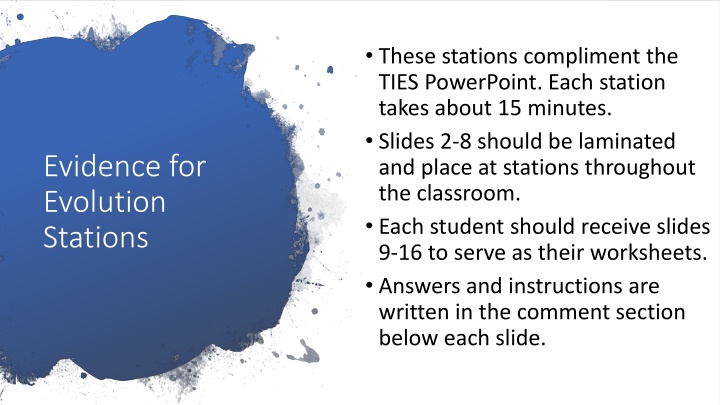

![[PDF] DOWNLOAD READ Diagnosis Solving the Most Baffling Medical Mysterie](/thumb/9855/pdf-download-read-diagnosis-solving-the-most-baffling-medical-mysterie.jpg)
